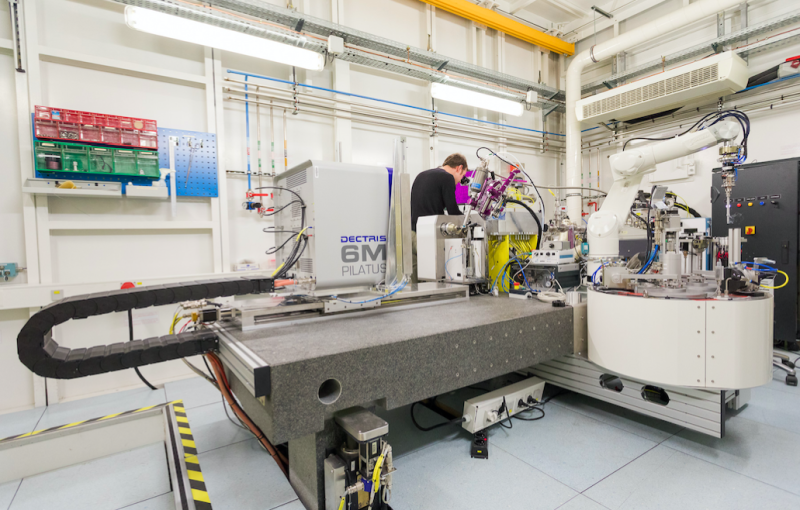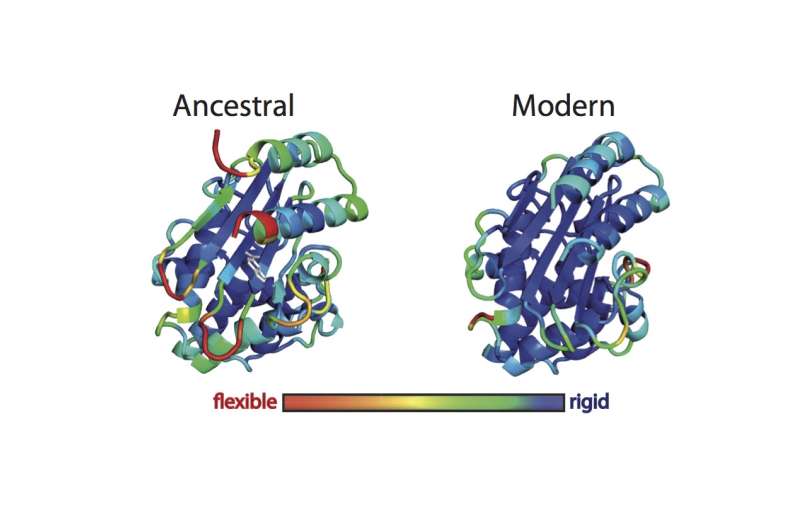Picture of ID23-1, one of the ESRF structural biology beamlines where the experiments were carried out. Credit: ESRF/P. Jayet
Enzyme activity is determined by the structure of a particular region of a protein called the active site. The generation of completely new active sites capable of enzyme catalysis is, arguably, one of the most fundamental unsolved problems in molecular biology.
Rational and modern design approaches to this problem have been developed using complex computational methods, but without conclusive results. Indeed, protein engineering studies often suggest that the emergence of completely new enzyme active sites is highly improbable.
Many years ago, Roy Jensen (currently at the University of Kansas Medical Center) proposed that primordial enzymes were capable of catalyzing a diversity of reactions. Based on this work, a multi-institutional collaborative of scientists explored and tested these notions using resurrected Precambrian β-lactamases as scaffolds for the engineering of completely new active sites. Precambrian β-lactamases are proteins approximately 3 billion years old. Basically, the scientists brought these ancient proteins back to life so that they can be studied to better understand how complexity in species arises.
How is it possible to resurrect ancestral proteins? Proteins are made from various combinations of amino acid building blocks, with a nearly endless variety of complexity and function. Researchers have compiled large databases of protein sequences. By comparing today's sequences to each other within an evolutionary framework, scientists can reasonably infer the sequence of an ancestral protein from which the modern versions descended using models of sequence evolution.
"The properties of these ancestral proteins (Precambrian β-lactamases) confer high structural stability and promiscuous enzymatic activity, meaning that they are capable of reacting with a variety of substances. These properties support the biotechnological potential of Precambrian protein resurrection because both high stability and enhanced promiscuity are desirable features in protein scaffolds for laboratory-directed evolution and molecular design," explains first author Valeria A. Risso from the University of Granada.
The 3-D structures of ancestral and modern β-lactamases, colored by the calculated RMSF. Credit: Jose Manuel Sanchez-Ruiz and Valeria A.Risso
Using these resurrected Precambrian proteins, the team demonstrated that a new active site can be generated through a single hydrophobic-to-ionizable amino acid replacement that generates a partially buried group with perturbed physico-chemical properties. "We have found that a minimalist design to introduce a de novo activity (catalysis of the Kemp elimination, a common benchmark in de novo enzyme design) fails when performed on modern β-lactamases, but is highly successful when using the scaffolds of hyperstable/promiscuous Precambrian β-lactamases," says Eric A. Gaucher from the Institute for Bioengineering and Biosciences, Georgia Institute of Technology.
For their experiment, the team used three structural biology beamlines at the ESRF, the European Synchrotron in Grenoble (France): ID29, ID23-1, and the fully automated " hands-off " beamline MASSIF-1, as well as the Xaloc beamline at Alba, the Spanish synchrotron. "Three-dimensional structural information derived from the data obtained at the ESRF was essential for the interpretation of the work, as it led to a high-resolution structure of the new active site and provided conclusive evidence of the role of protein re-organisation in the emergence of the new function," explains Jose A. Gavira, corresponding author, from the University of Granada.
This study confirms the potential of ancestral reconstruction as a tool for protein engineering. "We provide experimental and computational evidence that laboratory-resurrected ancestral enzymes will make much better scaffolds for new function engineering due to its high stability and dynamics features," says Jose M. Sanchez-Ruiz.
The innovative combination of bioinformatics, computational biology, structural biology and biophysics allowed researchers to delve deep into evolutionary time, and change the course of an enzyme's evolutionary potential. "Learning more about primordial life, and how it can be manipulated, will open up a lot of new avenues for science and shed light on the puzzle of how complex biological systems evolve at the most fundamental molecular level," says corresponding author Lynn Kamerlin from the Department of Cell and Molecular Biology, Uppsala University. This study was published in Nature Communications.
More information: Risso, V. A. et al. De novo active sites for resurrected Precambrian enzymes. Nature Communications. 8, 16113, DOI: 10.1038/ncomms16113
Journal information: Nature Communications
Provided by European Synchrotron Radiation Facility


.jpg)




















